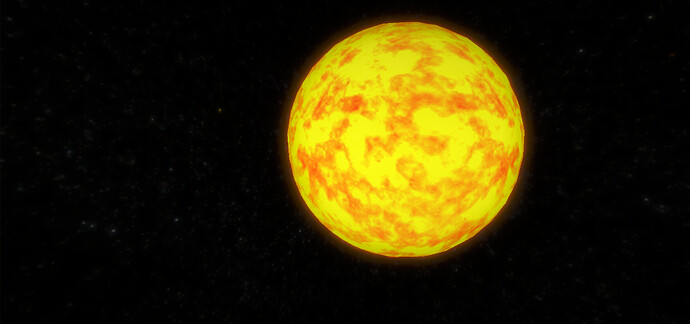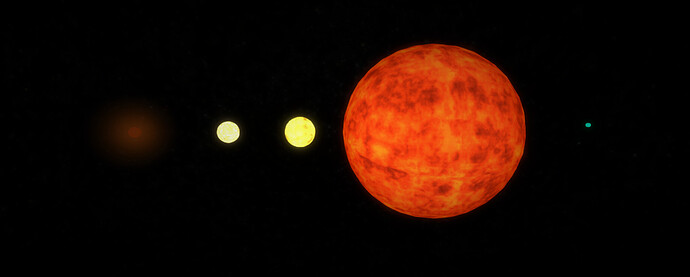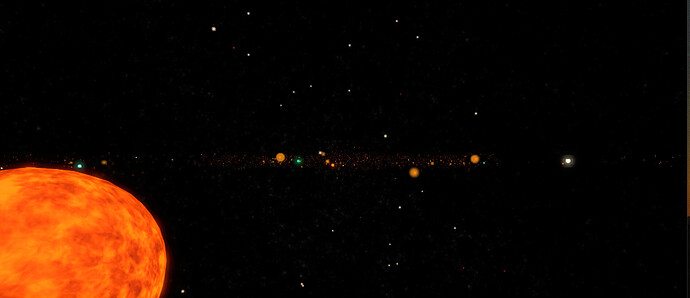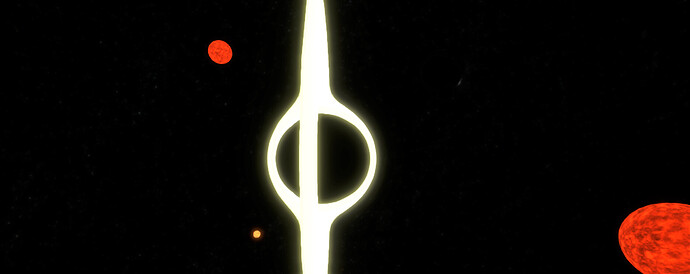What’s your ant game gonna be about (besides ants, obviously)? Also an rts?
idk yet. Probably just a click and hunt style game where you get new ants? Something simple.
You fools. You thought this thread was over just because I stopped developing my game? Think again! I always have at least three projects going at once. This time I started doing something that might actually help Thrive one day: I’m making a galaxy generator. I’m not sure how detailed I’ll go with this yet. I’d like to have a star-map and seperate star systems (procedurally generated.)
For now here’s a pretty screenshot of a star:
The star is fully recoularable. It can be any mix of bright and dark colours, though some look pretty ugly. I made it by taking a texture of the sun, introducing some noise to randomise it, and then seperately recolouring the highlights and shadows. The texture is then triplanarly mapped onto a sphere to remove weirdness with UV coordinates.
If you haven’t noticed yet, I have a lot of free time lately.
I’ve made some progress working on star math, but I can’t say that what I’ve done is 100% accurate. As it turns out, stars are incredibly complex objects, probably about as complex as any planet. This means summarising them in a couple of equations is basically impossible. Furthermore, scientists don’t actually know everything about the inside of stars and how they form yet.
That’s why my equations come from statistics more than physics. Overall, my goal with this project is to create something that could survive a casual inspection by an astronomer. It doesn’t have to simulate everything in detail (that would be a better project for a nobel prize than a game), but the numbers do have to look convincing.
I won’t bore you with the exact equations I used.
The gist is that I randomly generated a mass according to statistical probabilities, and than used that to derive (approximately), a radius, a temperature, a luminosity, and a lifetime for each star. The star’s colour is based on its temperature. To demonstrate the lifetime of a star here’s 5 instances of the exact same star:
From left to right we see: A nebula that’s starting to consolidate (protostar), A main sequence star, a subgiant, a giant, and a stellar remnant (the supernova itself is not pictured).
It’s time for your weekly screenshot
This time I have, not a star, but a galaxy! I have a lot to say about this one:
First of all, the structure of the galaxy. You can’t see it very well yet, because the distance between the stars is very big, and I haven’t implemented the interstellar gasses yet. However, this blob of stars is already shaped like a galaxy. The outermost layer is the halo: stars and small companion galaxies (the white blobs on the outside) that are orbiting the main galaxy. I modeled it as a sphere surrounding the centre of the galaxy. This picture was taken from a halo star to the side of the galaxy, looking unto it from the flat side. It is lonely all the way out here in the halo.
The line of stars you see is the disk, here is where the majority of the stars in the galaxy are. The disk is modeled as a thick circle of stars. The spirals arms are also within the line of stars, but you can’t see them because the disk covers it. I used a fermat’s spiral to make it. Contrary to popular belief most stars in the galaxy are in the disk, not the spiral arms. The reason the arms look brighter is because the stars born there are bright and young, and because it contains a lot of interstellar gas.
In the middle of the picture you can see a flattened sphere of stars bulging out from the disk. This is the galactic core, the densest region of a galaxy. Most scientists think that a massive black hole is at the centre of the core, a good subject for next week :).
You can also notice what kind of stars are in this picture. Click on the picture to zoom in and see the individual dots. I used statistics to figure out exactly how common each kind of star should be, so this is accurate to real life. You can see that small red/orange stars make up the vast majority of all stars in the galaxy. Larger yellow/white stars are much rarer. Even more uncommon are the bright blue stars. Just like the colour, the lifespan of stars also has a realistic distribution. Most stars are in the main sequence, but if you look closely, you can pick out some giants and some protostar-nebulas in this picture.
Today I added something new to my galaxy, the weirdest, least logical, most physics-defying object in all of existance: A black hole.
I was gonna post this last week but black holes are my favourite stellar objects so I wanted to take my time to get the shader magic right. I love how large black holes (like the one at the centre of the galaxy) can be striking and have these massive accretion disks, while smaller black holes can be insidiously hard to spot (Hint: there are 2 black holes in this image); the full power of a star packed into an object barely a few kilometres across.
The reason black holes look so trippy is because their gravitational pull is so strong that it bends nearby spacetime and any light in it. This distorts the image of any objects behind the black hole. The yellow-white disk in this picture, for instance, is completely flat. It is space itself that is bent, causing this ‘halo’ to appear around the black hole. Doing the math to actually represent this realistically took a lot of work so I hope you like the final look!



